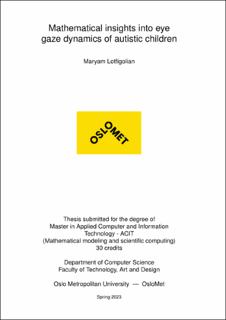| dc.description.abstract | Early detection and diagnosis of Autism Spectrum Disorder (ASD) is crucial for effective intervention and improved outcomes. Eye-tracking technology offers a non-invasive and objective method for detecting autism symptoms, as individuals with ASD often exhibit distinct gaze patterns. In this study, we aim to use eye-tracking data to distinguish individuals with ASD from those without, by analyzing the statistics of saccades and fixations. The study aims to go beyond simply identifying where individuals with ASD look and instead focuses on how they perceive images. By comparing our approach to other methods in the literature, we seek to improve the accuracy of autism diagnosis. Specifically, we use Hidden Markov Models (HMMs) to model gaze dynamics and apply power analysis to identify the most informative model parameters for future classification of individuals with and without autism. The use of HMMs and power analysis in this study provides an informative approach to understanding gaze dynamics in individuals with and without ASD, with potential implications for future research and clinical applications. | en_US |
